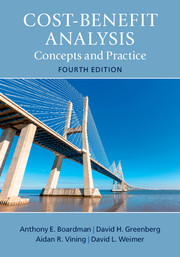Chapter 16 - Shadow Prices from Secondary Sources
from PART III - VALUATION OF IMPACTS
Summary
Policy analysts typically face time pressure and resource constraints. They naturally wish to do cost-benefit analysis as efficiently as possible and without getting into estimation issues beyond their competence. Anything that legitimately lowers the cost of doing CBA increases the likelihood that any particular CBA will be worth doing—in effect, it increases the chance that a CBA of doing a CBA will be positive.
In order to evaluate existing or proposed policies and projects, analysts require credible measures of the social values of the impacts. As we saw in Chapter 4, where these impacts occur in efficient markets, the value of these impacts can be estimated from changes in social surplus. Estimating social surplus requires knowledge of the appropriate demand and supply curves. When knowledge of these curves is not readily available, we may use the methods in Chapters 12 through 15 to value impacts. Most of these methods, however, are expensive and time consuming. What else could the analyst do? Two situations are worth discussing in more depth.
In the first situation, the analyst believes that it is necessary to estimate the demand curve in order to measure consumer surplus. As we discuss in Chapter 13, this is relatively easy if we know one point on the demand curve and we have an estimate of its elasticity or slope at that point. Fortunately, economists have estimated price elasticities of demand, cross-elasticities, and income elasticities for a range of specific goods. Many elasticities have been summarized in survey articles. Because these elasticities are based on the responses of people to similar price changes in the past, they provide an empirically grounded basis for predicting the responses to proposed price changes. For example, how consumers responded to a price increase for water in New Mexico can be reasonably used to estimate how they will respond to a similar price increase in Arizona. In addition to own-price elasticities, estimates of cross-price elasticities, which identify changes in the demand for a good that are likely to result from changes in the prices of other goods, though less often available, are frequently useful. For example, are transportation and various forms of communications (such as telecommuting and teleconferencing) complements or substitutes?
- Type
- Chapter
- Information
- Cost-Benefit Analysis , pp. 406 - 442Publisher: Cambridge University PressPrint publication year: 2017



